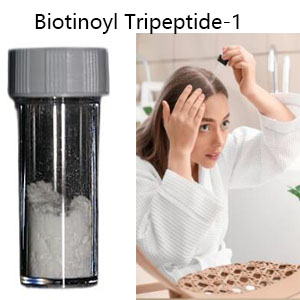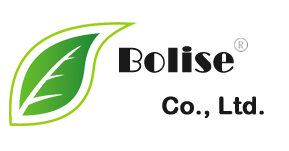Biotinoyl Tripeptide-1: Hair & Skin Boost for Enterprises

If you’re in the skincare or haircare industry, Biotinoyl Tripeptide-1 is likely on your radar as a game-changing ingredient. This synthetic peptide, combining biotin (vitamin B7) with the tripeptide-1 (Gly-His-Lys), is a powerhouse for promoting hair growth and skin rejuvenation. Known for its ability to strengthen hair follicles, enhance eyelash density, and support skin repair, it’s a go-to for enterprise brands crafting premium serums, shampoos, and anti-aging creams. Let’s dive into its science, benefits, and practical applications to help your brand leverage this innovative peptide effectively.
Understanding Biotinoyl Tripeptide-1
Biotinoyl Tripeptide-1 is a fusion of biotin, a vitamin renowned for supporting hair and nail health, and a tripeptide (GHK) that signals cell repair and growth. Its molecular weight of 566.7 g/mol and water solubility make it ideal for cosmetic formulations like serums and mascaras. By stimulating scalp micro-circulation and anchoring molecules like collagen IV and laminin 5, it strengthens hair follicles and promotes tissue repair. This dual action makes it a versatile ingredient for both haircare and skincare products targeting enterprise markets.
How It Works in Formulations
The peptide’s structure allows it to penetrate effectively, activating tissue repair gene expression and boosting keratinocyte proliferation. In haircare, it extends the anagen (growth) phase of hair follicles, with studies showing up to 121% increased hair growth when used at 3-5% concentration. For skin, it aids in repairing sun damage by enhancing collagen synthesis, making it a valuable addition to anti-aging products. Its stability in water-based solutions (pH 3.5-6.5) ensures consistent performance in professional-grade formulations.
Key Benefits for Hair and Lashes
Biotinoyl Tripeptide-1 shines in haircare, particularly for lash and brow serums. A clinical study with 30 volunteers using a 2% concentration mascara showed 17% longer and 19% thicker lashes after 30 days. By inhibiting 5-alpha-reductase, it reduces dihydrotestosterone (DHT) production—a key cause of hair loss—making it a non-hormonal alternative to prostaglandin-based products. This peptide also strengthens hair anchorage, reducing breakage and promoting fuller, healthier strands, ideal for enterprise brands targeting thinning hair or sparse lashes.
Enterprise Applications
For B2B clients, this peptide’s versatility is a major draw. It’s used in hair-thickening serums, shampoos, conditioners, and even mascaras, with recommended dosages of 1-3% for optimal results. Its ability to work across all hair types, from thinning to coarse, makes it a staple for brands developing inclusive product lines. Pairing it with ingredients like red clover extract or acetyl tetrapeptide-3 can amplify its anti-hair-loss effects, offering a competitive edge in premium haircare markets.
Skin Rejuvenation and Repair
Beyond hair, Biotinoyl Tripeptide-1 supports skin health by promoting cell proliferation and differentiation. It enhances the synthesis of extracellular matrix components, like collagen and laminin, which are crucial for skin firmness and elasticity. Its anti-aging properties help reduce fine lines and repair UV-induced damage, making it a smart choice for enterprise-grade anti-aging creams and serums. Its low irritation profile, as noted by EWG’s Skin Deep database, ensures it’s safe for diverse skin types, including sensitive ones.
Practical Formulation Tips
When formulating with Biotinoyl Tripeptide-1, keep temperatures below 40°C to preserve its potency. Use it in water-based emulsions or serums, ensuring proper pH (3.5-6.5) for stability. Store the peptide powder in a cool, dry, light-protected environment to maintain efficacy. For enterprise clients, combining it with complementary actives like Capixyl or Procapil can enhance results, but always conduct patch tests to ensure compatibility with other ingredients in complex formulations.
Safety and Regulatory Insights
Is Biotinoyl Tripeptide-1 safe for enterprise use? The EWG rates it as low hazard, with no significant concerns for allergies, toxicity, or irritation. Its synthetic nature ensures consistency, and it’s not listed on restricted substance lists, making it compliant for global markets. However, brands should verify formulations with regulatory bodies like the EU’s COSING database to ensure compliance. Its non-hormonal mechanism makes it a safer alternative to traditional hair growth ingredients, appealing to health-conscious consumers.
Guiding Your Brand’s Strategy
For enterprise brands, integrating Biotinoyl Tripeptide-1 requires strategic formulation. Use it in targeted products like lash serums or anti-aging creams to maximize consumer appeal. Highlight its science-backed benefits—such as clinical evidence of lash growth and hair density—in marketing to build trust. Ensure consistent application instructions (e.g., twice-daily use for serums) to deliver results. By leveraging this peptide’s proven efficacy, your brand can stand out in the competitive B2B skincare and haircare markets.


